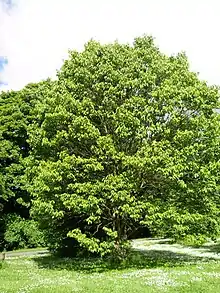北枳椇
北枳椇(学名:),又名玄圃梨[1]、拐棗[2]、萬壽果,为鼠李科枳椇属[2]下的一个硬木的物种。高大乔木或稀灌木[2]。
| 北枳椇 | |
|---|---|
 | |
| 科学分类 | |
| 界: | 植物界 Plantae |
| 演化支: | Tracheophyta |
| 演化支: | 被子植物 Angiosperms |
| 演化支: | 真双子叶植物 Eudicots |
| 演化支: | 蔷薇类植物 Rosids |
| 目: | 蔷薇目 Rosales |
| 科: | 鼠李科 Rhamnaceae |
| 属: | 枳椇屬 Hovenia |
| 种: | 北枳椇 H. dulcis |
| 二名法 | |
| Hovenia dulcis | |
| 異名 | |
| |
北枳椇分佈於亚洲,由中华人民共和国東部及朝鮮半島到喜马拉雅山脉海拔二千米以下山區裡的沙地或比較鬆軟的泥土。
北枳椇除了在其原生地,也被當作觀賞樹而引進其他國家種植。其果實可食用,有漢醫研究指可清肝毒,並製作成健康飲品在韓國發售。然而,本物種在巴西卻被視為入侵物種,對當地的亞熱帶雨林造成威脅[3]。
用途
參考文獻
- 米倉浩司; 梶田忠. . 2003- [2011-07-04]. (原始内容存档于2012-06-15) (日语).
- . 中国植物物种. 昆明: 中科院昆明植物研究所. [2013-01-18]. (原始内容存档于2016-03-05).(简体中文)
- Cf. Dechoum M, T Castellani, S Zabra, M Rejmànek, N Peronni & J Tamashiro (2014) Community structure, succession and invasibility in a seasonal deciduous forest in southern Brazil. Proceedings of the 8th International Conference on Biological Invasions (Neobiota 2014), p. 8.
- Sukin, Kamol. . [2019-01-01]. (原始内容存档于2015-08-24).
- Pakkad, G.; Elliott, S.; Anusarnsunthorn, V. . Proceedings of the Southeast Asian Moving Workshop on Conservation, Management and Utilization of Forest Genetic Resources 25 February-10 March 2001, Thailand. [2019-01-01]. (原始内容存档于2019-02-06). 参数
|journal=与模板{{cite web}}不匹配(建议改用{{cite journal}}或|website=) (帮助)
延伸閱讀
- Huxley, Anthony Julian; Griffiths, Mark. . 1992-04-01. ISBN 978-0-333-47494-5.
- Macoboy, Stirling. . 1986. ISBN 978-1-86302-131-9.
- Fang, Hsun-Lang; Lin, Hui-Yi; Chan, Ming-Che; Lin, Wei-Li; Lin, Wen-Chuan. . American Journal of Chinese Medicine. 2007, 35 (4): 693–703 (英语).
- Koller, G.L. and Alexander, J.H. "The raisin tree: Its use, hardiness and size."Arnoldia 39.1 (Jan/Feb 1979): 6-15.
This article is issued from Wikipedia. The text is licensed under Creative Commons - Attribution - Sharealike. Additional terms may apply for the media files.